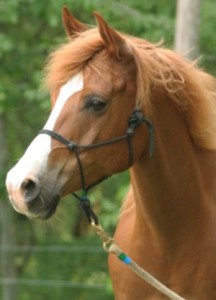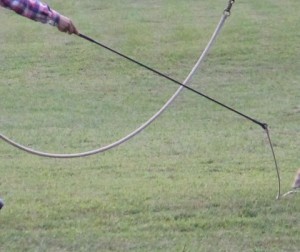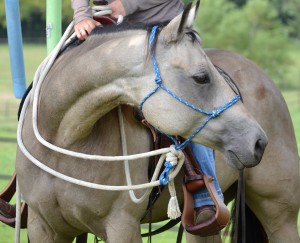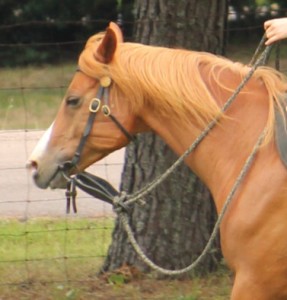In my program, students learn how to apply the Octave of Excellence™ to any daily interactions and training with their horses. The third note on the octave, E, stands for equipment. The equipment you use becomes more than just a means of getting your horse from point a to point b; instead, it becomes a channel of communication. Safety, quality of feel, and precision of communication help determine what types of tools you should use with your four legged partner. The foundational and advancement equipment I show here helps teach both the horse and the human the required feel necessary to develop a harmonious partnership.
Soft rope halter and 12′ Lead – The rope halter allows for the desired softness in communication because it rests lightly, almost non-existent, when the horse yields willingly. However, it also gives ideal control because it discourages the horse from leaning into pressure. The 12′ length is perfect for beginning the basic yields and training patterns while still being useful in daily handling. The rope material slides easily through the horseman’s hands, and the weighted snap provides both a gradual increase in and a quick release from pressure, all contributing to the development of lightness. The popper on the end can serve as a source of rhythmic pressure if needed.
Support Stick and Extension String – For safety purposes, the Support Stick allows the horseman to stay a safe distance from the horse when teaching the basic maneuvers. For communication purposes, the Support Stick helps guide a horse much like a mare might use her neck to guide her foal, or a herd leader might direct a herd member through rhythm with its leg or tail. The Support Stick is an extension of the horseman’s hand, not a whip or correction tool, and it should convey the same amount of love and leadership. The string gives the horseman a little extra distance for communication at higher speeds and from farther distances.
22′ Line – The 22′ line is an advancement tool for building speed and communication at longer distances. It allows for greater range of motion and play, or greater retreat, depending on the horse’s nature. The added length is also ideal for teaching more advanced maneuvers without requiring excessive flexion. It is made of the same material as the 12′ Line to maintain the same level of feel and softness.
Rope Hackamore – The Rope Hackamore allows riders to learn the art of softness in their hands without hardening the horse’s mouth while they practice. It is a great tool for casual riding, for practicing lateral flexion exercises in all gaits, and for building impulsion. Riding in the rope hackamore helps emphasize the principle that bits are for communication, not for control. When control is needed, only one rein at a time should be engaged – pulling on two reins puts more power to the horse’s engine (the hindquarters) and does not truly shut them down or get their mind reconnected with you. One rein for control – two reins for communication.
Snaffle Bridle – The Snaffle Bridle consists of a sweet iron snaffle bit, slobber straps and mecate reins. The sweet iron snaffle is a great introductory bit. It is best suited for the style of one-rein riding utilized in the hackamore, and the copper inlays encourage moisture in the horse’s mouth. The slobber straps work much like the snap on the 12′ and 22′ lines – they slow down the engagement of the reins to the bit and they speed up the release from the rider’s hands. The mecate reins are made from the same material as the two lines, and can be extended out to 22′, or retied to make reins and a 12′ line. This bridle is perfect for developing the yields and patterns in a bit and for trail riding or other casual outings. Note – this is by no means the only bit I ride in. Other bits become more suitable when heading towards more sport specific work or collection. Just remember, bits are for more precise communication, not more control.





